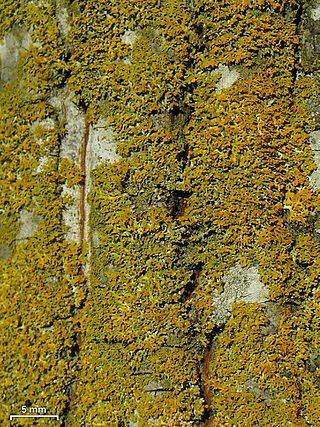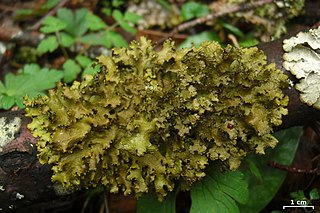
Cetraria is a genus of fruticose lichens that associate with green algae as photobionts. Most species are found at high latitudes, occurring on sand or heath, and are characterised by their "strap-like" form with spiny lobe edges. The lobes can range from narrow and linear to broader and flattened, often forming loose or densely packed cushions. Their distinctive spiny margins serve both a defensive role and aid in vegetative reproduction through fragmentation. The genus was created by Erik Acharius in 1803 and belongs to the large family Parmeliaceae. While originally a species-rich genus, taxonomic revisions since the 1960s have split many species into new genera, though the exact circumscription remains debated among lichenologists.

Ahtiana is a fungal genus in the family Parmeliaceae. A monotypic genus, it contains the single species Ahtiana sphaerosporella, the mountain candlewax lichen, found in western North America. The species was originally classified as Parmelia sphaerosporella by Johannes Müller Argoviensis in 1891, before Trevor Goward established the new genus Ahtiana in 1985, naming it after Finnish lichenologist Teuvo Ahti. This foliose lichen is characterised by its pale yellowish-green thallus, spherical spores, laminal apothecia, and the presence of usnic and caperatic acids. It primarily grows on the bark of whitebark pine in subalpine and montane regions, though it occasionally colonises other conifers outside its preferred host's range.

Arctocetraria is a genus of fruticose lichens in the family Parmeliaceae. It has three species.

Cetrariella is a genus of foliose lichens in the family Parmeliaceae. It contains three species.

Esslingeriana is a fungal genus in the family Parmeliaceae. The genus is monotypic, containing the single foliose lichen species Esslingeriana idahoensis, commonly known as the tinted rag lichen. It is found in northwestern North America.

Himantormia is a genus of lichen-forming fungi in the family Parmeliaceae. It consists of two species found in the southernmost parts of South America and Antarctica. Both species are characterised by a paraplectenchymatous cortex composed of large, dark pigmented cells, a pachydermatous medulla, and the absence of lichenin in their cell walls. While morphologically similar in some aspects, the species can be distinguished by their lobe shapes, cortex cell sizes, medulla structure, and distinct secondary metabolite compositions, with H. deusta producing fumarprotocetraric acid as its major compound and H. lugubris containing alectorialic acid as its primary metabolite.

Usnocetraria is a small genus of lichen-forming fungi in the family Parmeliaceae. It contains two species of corticolous (bark-dwelling), foliose lichens.
Filsoniana rexfilsonii is a species of saxicolous (rock-dwelling), crustose lichen in the family Teloschistaceae. Found in Australia, it was formally described as a new species in 2007. The thallus of Filsoniana rexfilsonii comprises brownish-orange squamules each hosting one to four reproductive structures.
Eilifdahlia sergeyana is a species of saxicolous (rock-dwelling), crustose lichen in the family Teloschistaceae. It is endemic to Kangaroo Island in South Australia. The lichen thallus has an uneven and scaly texture, forming patches up to 40 mm wide in dull greenish-grey or brownish-grey. Its fruiting bodies (apothecia) are orange to yellow, with a biatorine structure, and range from 0.5 to 1 mm wide. These apothecia have a matte surface and a cup-shaped margin containing golden-yellow crystals. The paraphyses within are slender and branched, and the asci contain ellipsoid spores.
Placolecis sublaevis is a species of saxicolous (rock-dwelling), crustose lichen in the family Catillariaceae. It is found in Yunnan and Sichuan, China. The crust-like, radiating body of the lichen forms irregular patches or clumps and includes numerous false conidiomata, a type of asexual reproductive structure, within its thallus. Its lobes, dark brown and slightly flattened at the top, form larger groups at the edges and contain an upper layer composed of loosely interwoven cells and a lower inner tissue that varies from reddish-orange to white.
Dufourea angustata is a species of saxicolous (rock-dwelling), crustose lichen in the family Teloschistaceae. It is widely distributed across Australia.
Filsoniana ferdinandmuelleri is a species of saxicolous (rock-dwelling), crustose lichen in the family Teloschistaceae. It is found in Australia. The lichen has a squamulose (scaly) thallus, with a range of bright yellow to greenish-yellow and brownish-orange colours in its soredia and apothecia, respectively. The areoles of this lichen are varied in size, slightly raised from the thallus surface, and each carries one to four apothecia. The soralia are rounded or irregularly shaped, covering most of the thallus surface as a yellow to greenish-yellow mass. The apothecia have dark brownish-orange discs, surrounded by slightly paler yellow margins, with the spore-bearing asci containing typically eight brownish-golden ascospores.

Gallowayella weberi is a species of corticolous and saxicolous, foliose lichen in the family Teloschistaceae. Found in the eastern United States, it is a small lichen with a smooth yellow to orange upper surface and a contrasting white lower surface.

Tuckermannopsis orbata, commonly known as the variable wrinkle lichen, is a species of foliose lichen in the family Parmeliaceae. It is a small cetrarioid lichen, an informal growth form category that denotes lichens with erect, foliose thalli, and apothecia and pycnidia on the margins of the ruffled lobes. Tuckermannopsis orbata is found in Asia and North America, growing primarily on the wood and bark of mostly birch and coniferous tree branches and twigs.

Tuckermannopsis ciliaris is a species of corticolous (bark-dwelling), foliose lichen in the family Parmeliaceae. It was first described by Erik Acharius in 1810, initially classified in the genus Cetraria. The species was later reclassified into the genera Nephromopsis and then Tuckermannopsis, with some researchers proposing that certain cetrarioid genera, including Tuckermannopsis, should be merged into Nephromopsis. However, this suggestion was disputed, and both names, Tuckermannopsis ciliaris and Nephromopsis ciliaris, are used in recent literature to refer to this species.

Cetraria arenaria, commonly known as the sand-loving Iceland lichen, is a species of terricolous (ground-dwelling), fruticose lichen in the family Parmeliaceae. It was formally described as a new species in 1977 by the Norwegian lichenologist Ingvar Kärnefelt. The type specimen was collected in 1949 by Henry Imshaug from Mackinac County, Michigan, where he found it growing on sandy soil.

Usnocetraria oakesiana, commonly known as the yellow ribbon lichen, or the yellow-green ribbon lichen, is a species of corticolous (bark-dwelling), foliose lichen in the family Parmeliaceae. It occurs in Asia, Europe, the north-eastern United States, and eastern Canada.
Cetraria australiensis is a species of saxicolous (rock-dwelling), fruticose lichen in the family Parmeliaceae. It occurs in Tasmania, Australia.

Cladocetraria is a fungal genus in the family Parmeliaceae. It contains the single species Cladocetraria minuscula, a fruticose (shrubby) lichen. The genus was established in 2023 based on morphological and molecular studies that distinguished it from related genera. It is characterised by its small size, growing only 2–3 centimetres tall, with distinctive hollow, tube-like structures that branch in a fork-like pattern and have inward-curling tips covered in a white powdery coating. The lichen produces several chemical compounds, including usnic acid, which gives it its yellowish-green colour.

Cetraria sepincola, the chestnut wrinkle-lichen, is a species of foliose lichen in the family Parmeliaceae. It forms compact, cushion-like colonies typically 0.5–2 cm high, with a yellowish-green to dark brown upper surface and lighter underside. The species has a primarily circumboreal distribution and is widespread in northern regions, occurring from Alaska to northern California in North America and documented as far south as Argentina. While mainly found growing on woody species like Betula, Sorbus, Salix, and Alnus in bog environments and open areas, it can occasionally be found on dead wood and rarely on rock surfaces. Originally described by Jakob Friedrich Ehrhart in 1783 as Lichen sepincola, it was transferred to the genus Cetraria by Erik Acharius in 1803.












